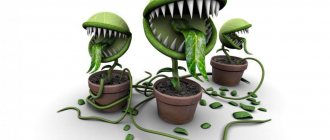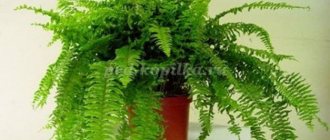Particularly dangerous
undoubtedly
Veh, or hemlock (Cicuta virosa)
According to legend, it was the hemlock drink that Socrates drank in prison (according to another version, it was hemlock, which will be discussed later). One of the most poisonous plants, especially dangerous because it is easily confused with other absolutely harmless umbelliferae. A distinctive feature of hemlock is the structure of the rhizome: it is internally divided by partitions into transverse cavities:
Hemlock rhizome. Photo from the website www.biolib.cz The entire plant is poisonous, but the maximum concentration of hazardous substances is in the rhizome. Vekh poses a threat not only to humans, but also to animals, so it should be disposed of both near housing and in places where livestock graze. At the same time, be careful - make sure that the hemlock juice does not get on the skin and mucous membranes.
Henbane (Hyoscyamus)
About a person who behaves inappropriately, they sometimes say that he “ate too much henbane.” In fact, the alkaloids contained in this plant cause confusion, visual disturbances and other extremely unpleasant symptoms. All parts of the plant are poisonous, but especially the small seeds, similar to poppy seeds.
Henbane. Definitely dangerous
Hemlock (Coniun)
Another dangerous representative of the umbrella family is the spotted or speckled hemlock. Extremely poisonous; dangerous for both people and animals. The alkaloids contained in all parts of the plant are deadly; poisoning develops quickly, is very difficult and often ends in the death of the victim from respiratory arrest. Hemlock juice causes skin irritation and dermatitis. It is necessary to learn to distinguish hemlocks from other umbrellas. Photo from the site static.panoramio.com A feature of the plant that allows it to be distinguished from other members of the family is the intense purple color of the lower part of the stem and spots of the same color on its surface (it was they who gave the hemlock the name “spotted”). If you grind the small leaves, you can smell an unpleasant “mouse” smell. Belladonna (Atropa belladonna), hellebore (Veratrum), and calla palustris are also extremely dangerous. The list presented is, of course, incomplete. It can take a long time to expand, but the point is probably not in the enumeration
You have probably noticed: the named plants - even the most poisonous ones - can only harm an ignorant person, and, moreover, a careless and imprudent one. Therefore, I am sure: the most important thing is to learn a reasonable attitude towards nature and its gifts; do you agree? There is no need to strive to completely remove or destroy potentially dangerous grasses, flowers and shrubs around you
This idea is not feasible. But you definitely need to understand them, find out the sources of the threat and understand how to protect yourself and your loved ones. I hope now you know: it's not too difficult.
FITOVERM
Place No. 3: FITOVERM is one of the best today. The action of the drug is aimed at destroying various insects - aphids, thrips, whiteflies, codling moths and others, including mites. The action of the drug is contact-intestinal; when the active elements enter the body of an insect, they paralyze and then lead to death. Advantages of the drug: it is of biological origin, the active substance of the drug is the waste products of soil inhabitants; the drug quickly decomposes in water and soil without causing harm to the environment; fruits treated with it can be used for food within two days. There are practically no disadvantages of the drug, the only thing is that it requires 2-3 times of treatment. More information about the drug
DECIS
Place No. 10: DECIS is a contact-intestinal insecticide that belongs to the group of synthetic peritricides. Used to protect various crops from a variety of pests. Contains a high concentration of the active ingredient deltamethrin - 250 g/l. The objects of its influence are aphids, psyllids, leafhoppers, whiteflies, scale insects, bark beetles, weevils, weevils, Colorado potato beetles, beetles, grain borers, moths, and codling moths. The advantages of the drug are high efficiency at low dosages, moderate danger to humans and animals, and safety for the soil. Decis is compatible with almost all growth stimulants, fungicides, and insecticides. Exceptions are alkaline products, for example, Bordeaux mixture.
Thus, each product is original in its properties, the chemical active substance on the basis of which it is made, or the biological mechanism of action. It has both undeniable advantages and significant disadvantages that limit their use. Therefore, when considering which insecticides to choose, it is worth considering many, many factors.
All of the above TOP-10 drugs have shown the best results in practice and are recommended for use by both agricultural technicians and amateur gardeners. Therefore, in order not to “shovel” a lot of information on what to choose, opt for one or more insecticides from the TOP 10 list.
When using, follow the instructions for the insecticide used; preference should be given to systemic and multicomponent preparations. When choosing, be guided by the balance “Efficiency-Safety”. Observe the dosage of drugs and the frequency of treatments. And although the TOP 10 includes mainly chemical insecticides, we recommend paying closer attention to biological insecticides.
Choosing plants depending on the interior
Plants don't just have to be suitable for children's learning. They should match the interior of children's rooms. Usually in kindergartens plants are placed along the walls. Hanging flowerpots containing bright compositions also look good. They can be rearranged during ventilation and cleaning. Do not use high floor stands as children are very mobile. They may hurt themselves by knocking over the stand.
When purchasing plants, consider the color scheme of the room. This is especially true when choosing bright plants with beautiful flowers. Consider everything - from the shade of the walls to the color of the furniture. They should be in harmony with other decorative elements.
Think about the emotional component. Monstera, which is a beautiful flowering plant, is well suited for this. But at night she doesn't look her best. Therefore, it is perfect for a kindergarten, since children attend during the daytime.
When choosing indoor plants for your kindergarten, consider all these factors. Children will enjoy their appearance and at the same time acquire skills in caring for plants. In addition, it instills attentiveness and develops commitment. Indoor plants are the best solution for a kindergarten.
Bulbous cunning
there is a simple remedy
It is safer to store planting material separately from daffodil products
Snowdrop (Galanthus nivalis)
Very poisonous; in traditional medicine it is used to produce potent drugs used in neurology, but traditional medicine does not use this plant due to the high risk of poisoning in case of overdose. Snowdrop bulbs and fruits are dangerous, the consumption of which can cause nausea and vomiting, and in severe cases, serious kidney damage.
Snowdrops are highly poisonous. Photo by Samdolis (Svetlana)
Narcissus
The bulbs are poisonous; the alkaloid lycorine they contain stimulates the vomiting center in the brain, so a “pleasant” pastime after tasting daffodils is guaranteed.
It is not advisable to taste daffodil bulbs






